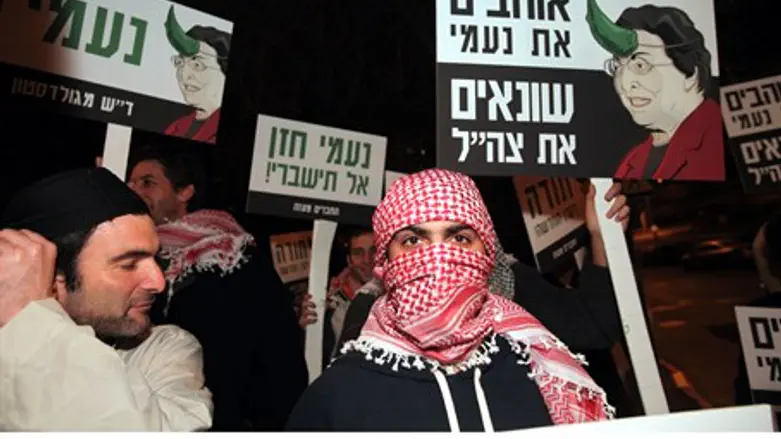
The controversial New Israel Fund (NIF), which supports a variety of ultra-leftist organizations in Israel, admits it has taken a pummeling from the grassroots-Zionist Im Tirtzu group, but promises it will launch a new strategic drive in three months' time.
According to left-wing paper Haaretz, NIF President Brian Lurie, and CEO, Daniel Sokatch, describe as “momentous” an upcoming meeting of the NIF board of directors, scheduled to be held in Israel in February, at which, Sokatch says, “new strategic directions will be set.”
Lurie referred to the attacks on the organization by Im Tirzu as "vicious", but claimed their effect on the NIF was only “minimal.” However, Haaretz says others describe the organization’s new direction as a reaction to the efforts to "delegitimize" the NIF, and that one donor said the NIF was headed toward greater "militancy".
Lurie admitted that the Im Tirzu campaign has damaged the NIF’s image among the Israeli public, while Sokatch told the paper that the NIF has been "galvanized" by the “militancy” of its opponents, including the Israeli government and security services.
Sokatch cites the arrests of leaders of the Sheikh Jarrakh movement, which opposes court-sanctioned Jewish resettlement of homes in eastern Jerusalem, and of Women of the Wall (WOW) activists, in this context.
The duel between Im Tirtzu and NIF is hardly a balanced one: while NIF partners with the huge Ford Foundation and has a budget in the tens of millions of dollars, Im Tirtzu's budget is a small fraction of that.
NIF's flagship organizations include the Association for Civil Rights in Israel, several extremist Israeli-Arab groups, and militant feminist groups that oppose Israeli "militarism" as part of a supposed "women's agenda." It is also seen as having great influence on Israel's judiciary and media.
In 2010, however, Im Tirtzu launched a campaign which exposed the connection between NIF-funded groups and the infamous Goldstone Report, revealing that almost every single NGO involved in the one-sided report was funded by the New Israel Fund.
The Goldstone Report was a UN document that claimed Israel had committed war crimes when it launched the Cast Lead counterterrorism operation in 2008-9, against Hamas. It was widely discredited after its publication and even its author wound up recanting its claims.
In response to NIF's funding of anti-Israel groups, Im Tirzu held protests against then-president of the NIF, former Meretz MK Naomi Hazan, convincing the Jerusalem Post to stop publishing her columns. The activists dressed up as Arabs and held signs saying "We love Naomi; We hate the IDF."
Im Tirtzu's campaign featured a cartoon of Hazan with a 'horn' tied to her forehead, its point stuck in the Israeli flag like a bull's horn in a matador's cape. The cartoon was a play on the Hebrew word 'keren', which means both 'fund' and 'horn'. Research by Im Tirtzu showed that 92% of the Goldstone Report's quotes from Israeli groups came from NIF-sponsored organizations.
Hazan was also criticized for signing a petition against Cast Lead on the day the fighting began, which accused the IDF of carrying out "a massacre."
Ronen Shoval, Chairman of Im Tritzu, told Arutz Shevain an interview that his movement and others like it could be doing a lot more to save Israel if only Jewish donors begin to think differently. Donors, he said, are used to buying houses from Arabs in Judea and Samaria or eastern Jerusalem, and settling Jews in them. That is important, but they should also be thinking about shaping public consciousness.
"The question is,” he explains, “do facts on the ground create public consciousness, or is it the other way around? The Jewish approach" he feels, "is that the universe was created through words: that is to say, consciousness creates reality.”
"Throughout the history of Zionism, these rival approaches competed with each other and complemented each other. Herzl believed in shaping consciousness and asked the world's powers for a charter to settle in the Land of Israel. The Hovevei Tzion movement, meanwhile, believed in buying 'another dunam and another goat.'
"These two great streams collided in the summer of 2005, in the Disengagement," Shoval explained. "The settlement movement thought that it was creating facts on the ground in Gush Katif – but it turned out that without proper consciousness, one government decision was enough for all of the communities there to be destroyed. It won't help us to buy another house in eastern Jerusalem, and another one after that, if they decide to hand over eastern Jerusalem to the Arabs in the end.”